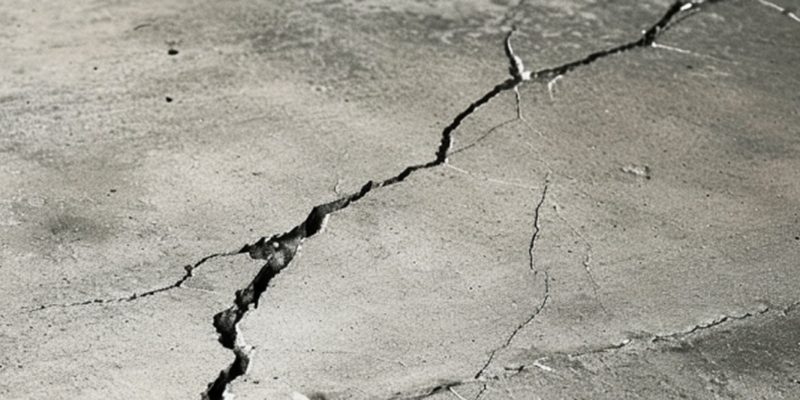Have you ever gazed at your new concrete driveway or patio and spotted those little cracks weaving across the surface? It’s a common sight and often a point of worry. Is it normal, or is it a sign of a problem? Relax, we’ve got you covered. In this expanded guide, we’re delving deeper into the world of concrete cracks. We’ll explain what these cracks really mean, explore their types, delve into what causes them, and discuss how you can fix them.
What Are Cracks in New Concrete?
Cracks in new concrete are like the wrinkles in a new shirt – mostly harmless but sometimes telling. These small fractures or lines appear on the surface of your concrete as it settles and adjusts to its new environment. But not all cracks are created equal. Some are just superficial, similar to the cracks you see on a dry lake bed, while others might need your attention. A good rule of thumb is to keep an eye on the width. If a crack is wider than the thickness of a credit card, it might be more than just a cosmetic issue.
Is Cracking Normal or a Concern?
Cracking in concrete is as inevitable as change in weather. It’s a natural part of the concrete’s life cycle. As concrete dries, it loses moisture, and this change can cause it to crack. It’s a bit like the settling of a house; small adjustments are part of the process. However, large or widening cracks can indicate underlying issues such as poor installation or environmental stress.
Understanding Concrete’s Nature
Concrete, despite being a robust and durable material, isn’t immune to the laws of physics. Like many other materials, it expands and contracts with temperature changes and moisture levels. This movement can lead to cracks, especially if the concrete was improperly mixed or laid. Knowing this helps in understanding why even your brand-new patio or driveway might show these signs of change.
Understanding the Different Types of Concrete Cracks
Cracks in concrete are as varied as the reasons behind them. Let’s break down the common types you might encounter:
Shrinkage Cracks: Picture a cake baking in the oven. As it heats, it rises and changes. Concrete does something similar as it dries. Shrinkage cracks are the most common type of cracks in new concrete. They occur because as concrete dries and loses moisture, it shrinks. This shrinkage causes the concrete to pull apart, leading to these cracks. They usually appear within the first month after pouring and are generally thin, like a hairline. Don’t worry too much about these; they’re a normal part of the concrete curing process.
Expansion Cracks: Now, think about ice cubes in a tray. As they freeze, they expand and fill the tray. Concrete, like those ice cubes, expands when it gets hot. In the heat of a Des Moines summer, your concrete driveway or patio can expand, pushing against anything in its path, like walls or other slabs. If the concrete can’t expand freely, it might crack to relieve the pressure. These cracks are more about the concrete finding room to move than anything else.
Craze Cracking: These are the fine, spiderweb-like cracks that spread across the surface of the concrete. They’re more about aesthetics than structural integrity. Think of them as the patina on a well-loved leather jacket – not necessarily damaging, but they do change the appearance. Craze cracks are caused by the surface of the concrete drying faster than the rest.
Heaving Cracks: These occur when the ground beneath the concrete freezes and thaws, lifting and pushing the concrete up. It’s like a tree root lifting a sidewalk. In areas like Des Moines, where freezing temperatures are common, heaving cracks can be a seasonal visitor.
Settling Cracks: Opposite of heaving, settling cracks happen when the ground under the concrete shifts or settles. Imagine building a sandcastle near the water; as the tide comes in and the sand shifts, parts of the castle might sink or crack. Similarly, if the soil beneath your concrete wasn’t properly compacted or if it’s too wet, your concrete might settle unevenly, causing cracks.
Each type of crack tells a story about what’s happening with your concrete – from the normal drying process to the effects of the Iowa weather. Understanding these types helps in identifying potential issues and taking appropriate actions.
Causes of Cracks in New Concrete
Understanding what causes cracks in your concrete can help you prevent them or address them effectively. Here are some common causes:
Water Ratio in the Mix
Just like in baking, the right mix matters. Concrete needs water to cure, but too much can weaken it. Think of adding too much water to your morning coffee – it gets diluted. A high water content makes concrete easier to pour but can lead to more shrinkage as it dries, causing cracks. Getting the water-to-cement ratio right is key to strong, crack-resistant concrete.
Improper Curing and Preparation
If concrete dries too fast, or if the base it’s poured on isn’t stable and well-prepared, cracks are more likely. It’s similar to painting a wall without priming it first. Proper curing allows concrete to reach its maximum strength evenly, reducing the likelihood of cracking. This includes controlling the environment around the concrete as it dries, like shielding it from direct sun or adding moisture to prevent too-fast drying.
Environmental Factors
In Des Moines, where the weather swings from hot summers to freezing winters, concrete is put to the test. Extreme temperature changes cause concrete to expand and contract, which can lead to cracks. Moreover, if your concrete slab is exposed to heavy rainfall or sits in a low area where water collects, the excess moisture can weaken the concrete and contribute to cracking.
Poor Construction Practices
If the concrete is not laid correctly, it can develop cracks. This includes not using control joints – pre-planned cracks that allow concrete to expand and contract without damaging the overall structure. It’s like designing a building without expansion joints; without them, the building can’t move safely with temperature changes.
Heavy Loads
Just like a bridge has a weight limit, so does your concrete. If too much weight is placed on it before it’s fully cured or if it’s simply not designed to bear heavy loads, it can crack under the pressure.
Substandard Materials
Using low-quality concrete or reinforcement materials can also lead to cracks. It’s akin to using weak wood to build a house. The strength and durability of the materials directly affect the integrity of the concrete.
Each of these causes is a piece of the puzzle in understanding why cracks appear in new concrete. Addressing these factors during installation and being mindful of environmental conditions can significantly reduce the risk of cracking.
Fixing Cracks in New Concrete
Even with the best preparation, cracks can still appear. Here’s how you can address them:
For Small, Hairline Cracks
These are usually not a structural concern and can often be fixed with a simple concrete sealant or filler. It’s a straightforward DIY job – think of it as caulking a window. These products can be easily found at your local hardware store in Des Moines. Just clean the crack, apply the filler, and let it set.
For Larger Cracks
Bigger cracks might need more attention. Patching them with a concrete mix might do the trick. For this, you’ll need to clean out the crack, prepare the patching material (following the instructions on the bag), apply it to the crack, and smooth it out. It’s a bit like patching a hole in drywall, but with concrete.
Professional Solutions
If you’re not comfortable doing it yourself, or if the crack seems serious, it’s always a good idea to call in a professional. They can assess the situation and determine the best course of action, whether it’s a simple fix or something more extensive.
NOTE
Remember, fixing cracks isn’t just about aesthetics; it’s about maintaining the integrity and longevity of your concrete. Addressing them promptly can prevent further damage and potential safety hazards.
FAQs About Cracks in New Concrete
Addressing Common Concerns
Homeowners often have questions about cracks in their new concrete. Here’s a comprehensive look at some frequently asked questions:
Is It Normal for New Concrete to Crack?
Yes, some cracking in new concrete is normal. As we’ve discussed, concrete undergoes a lot of changes as it dries and settles. Small, hairline cracks are usually not a cause for concern. They’re a part of the concrete’s natural curing process.
How Can I Prevent Cracks in My Concrete?
Prevention starts with proper installation. Ensure the concrete mix has the right water-to-cement ratio, the subgrade is well-compacted, and the concrete is cured properly. Also, consider the environmental factors like weather and moisture. Using control joints in your concrete slab can also help manage where the cracking occurs.
When Should I Be Concerned About a Crack?
Be concerned if a crack is wide enough to fit a coin or if it keeps growing. Also, if the crack is uneven (one side is higher than the other), it might indicate a more serious issue, like a problem with the subgrade or heavy loads.
Can Cracks Affect the Integrity of Concrete?
While small, surface-level cracks are usually not a structural issue, larger and deeper cracks can compromise the strength and safety of the concrete. If in doubt, it’s best to consult a professional.
Can I Repair Cracks in Concrete Myself?
Yes, for small, hairline cracks, DIY solutions like sealants and fillers can be effective. For larger cracks, patching with a concrete mix might be necessary. However, if the crack seems serious, professional assessment and repair are recommended.
Do Weather Conditions in Des Moines Affect Concrete Cracking?
Absolutely. The fluctuating temperatures and moisture levels in Des Moines can contribute to concrete expanding, contracting, and cracking. It’s important to consider these factors when installing and maintaining concrete surfaces.
How Long Does Repaired Concrete Last?
The longevity of repaired concrete depends on the extent of the damage, the quality of the repair, and ongoing maintenance. Properly repaired and maintained concrete can last for many years.
Conclusion
In conclusion, understanding cracks in new concrete is key to maintaining the beauty and functionality of your concrete surfaces. While small cracks are a normal part of the concrete’s life, larger or growing cracks should be addressed promptly. Proper installation, curing, and maintenance can go a long way in preventing cracks. If you do encounter them, there are both DIY and professional solutions available. Remember, taking care of these little signs early can save you from bigger problems in the future.

